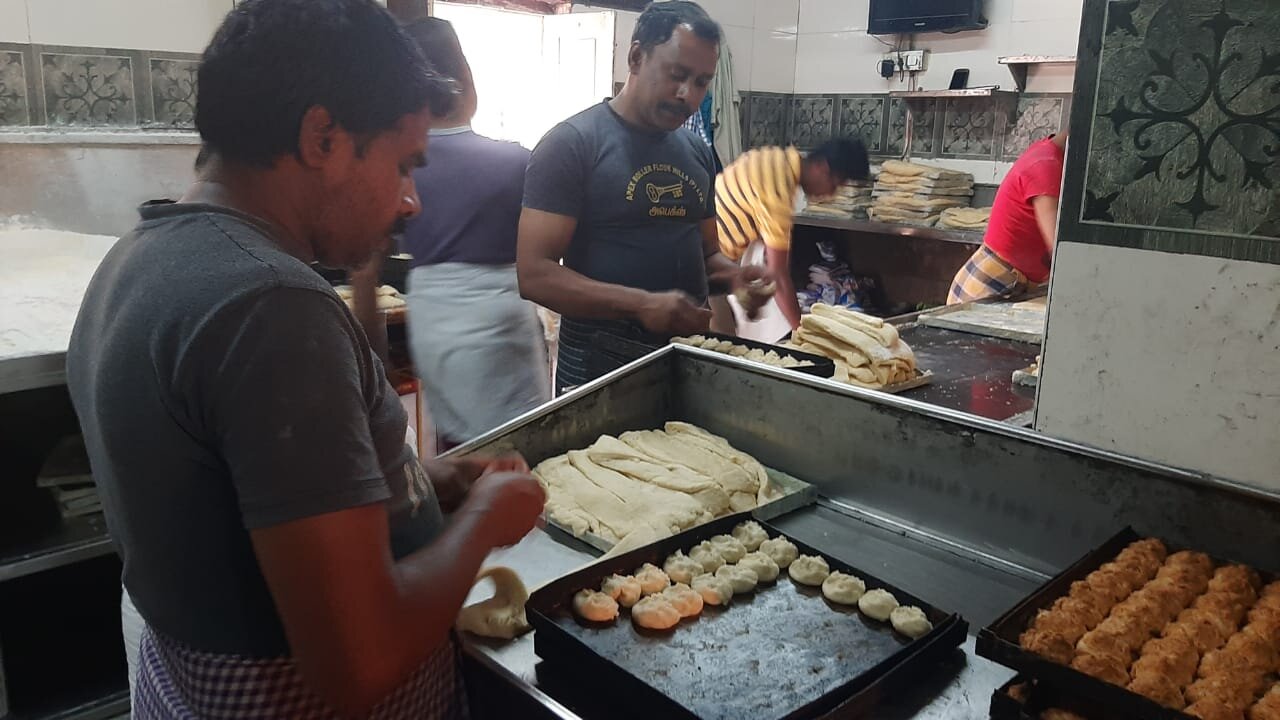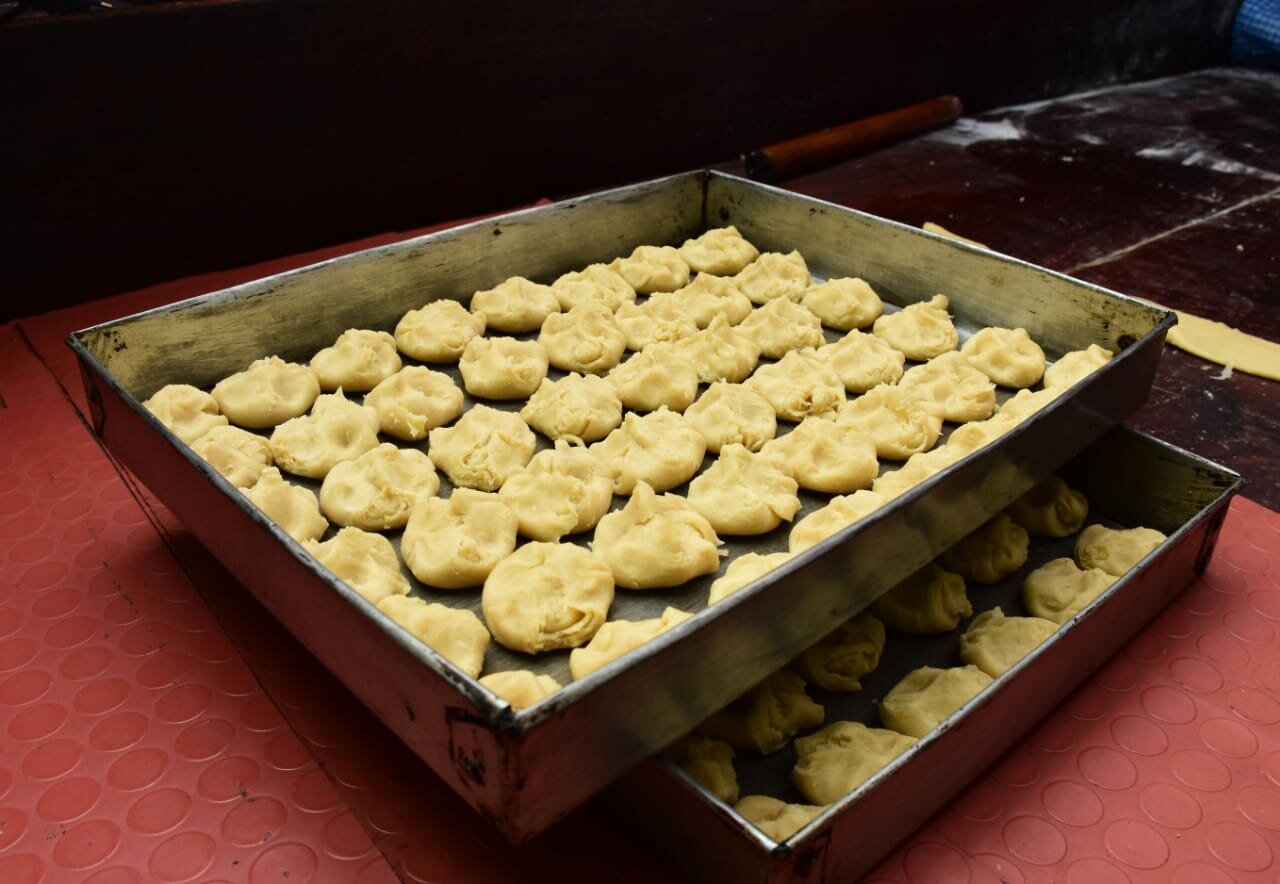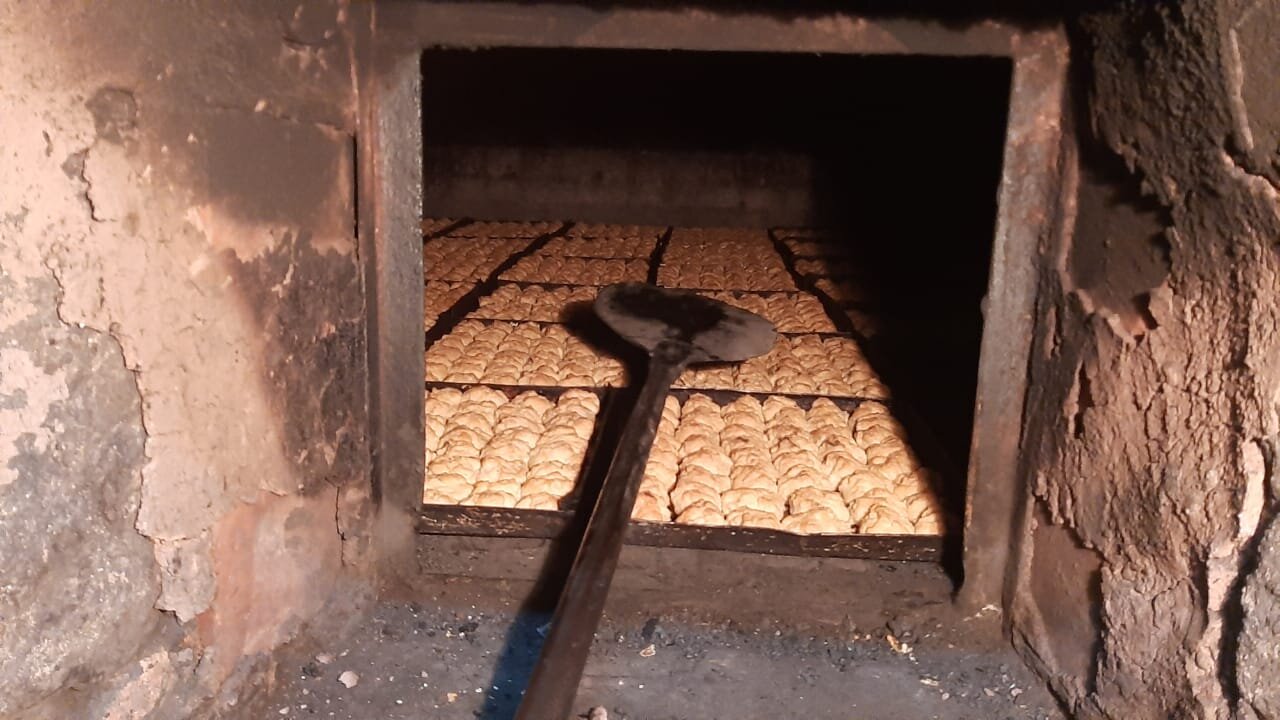What’s A Trip To The Hills Without Varkey?
Text by Megha Kaveri
Photographs by Sudhakar Balasundaram
Trays of just-baked varkeys.
Chai time anywhere in India is incomplete without something to bite into. In the plains, Indians predominantly rely on biscuits and deep-fried snacks to accompany a piping hot cup of chai. But in the Nilgiris, a district dotted with picturesque hill stations in south India, varkeys rule the roost. The process is simple: You take a varkey, dunk into a glass of chai and bite into its multilayered goodness.
At first glance, varkeys look like a modern-day cross between puff pastry and cookies. The snack consists of innumerable layers, all of which are crunchy and flaky. Usually dome-shaped, varkeys are made of refined flour, sugar, salt and hydrogenated vegetable oil (or vanaspati) and are mildly sweet to taste. When dunked into chai, the layers soften and melt in the mouth.
Aptly called the ‘Queen of the Western Ghats’, the Nilgiris (literally ‘Blue Mountains’ in Tamil) are located along the border of Kerala and Tamil Nadu in south India and boast of a rich history. For anybody who grew up in this part of the country, summer vacations invariably meant a trip to the Nilgiris. Along with the lush botanical gardens, expansive tea plantations and homemade chocolates, tourists made sure they tried varkeys when they visited. To this day, it is not uncommon to catch glimpses of families buying varkeys in large quantities to take back home with them. This crucial purchase is not just for personal consumption but also to distribute to their neighbours and friends.
Once a popular campsite for the officers of the British era, who settled in and around Ooty (the hill station that is often called the ‘queen of the hills’), the Nilgiris has its own culinary legacy. It is influenced in some measure by the remnants of colonial food habits, along with the age-old customs followed by indigenous tribes such as the Todas and Badagas. While Todas are a Dravidian tribe native to the hills, Badagas are an ethno-linguistic group of people who live in the Nilgiris in settlements called ‘attis’. Most of their traditional cooking is based on grains and dairy products, without adding vegetables or meat.
What gives varkeys a sense of exclusivity is the ingredient used to initiate fermentation. “In the hills, we use a homemade fermentation agent called 'maava' to aid the process. It is similar to fermenting curd at home,” says Mohammed Farooq, head of the Ooty Varkey Manufacturers Association. Made of maida, semolina, sugar and a small quantity of mashed bananas, maava is the name given to a previously prepared batch of dough that has been allowed to ferment. “The perfect maava is achieved only at the temperature prevalent in the hills,” says Farooq. “In the plains, they use yeast, which we don’t even touch. This adds a great deal of special flavour to the varkeys made in the hills.” The domes of dough are then placed on trays and baked in traditional brick ovens, which add more flavour to the dish and give it the perfect texture — crunchy layers and soft insides.
***
Some theories maintain that the snack got its name from a baker named Varkey.
For a dish that boasts such exclusivity, its origins involve a lot of guesswork. Over decades, there have been many anecdotes about how varkeys came into being. The most popular story is about a cheeky Malayali baker who came to the Nilgiris along with his friends who worked in the tea plantations. The story goes like this: The baker, named Varkey, one day messed up the proportion of ingredients while making puff pastries and ended up with something that had a harder outer layer. Someone who tried the new product took a liking to it and asked him what it was called. Pat came the reply — Varkey! Yes, the man had named the new pastry after himself.
However, this theory has its set of detractors, including Farooq. “The workers who came to work for the British in the tea plantations here were predominantly from Kerala. So there is no doubt that they would have been the first to try making varkeys. But the influence for it might have been from the British,” he says, rubbishing the idea of a Malayali worker inventing the varkey.
Reverend Philip Mulley, a historian and trustee of the Keystone Foundation, which works closely with the indigenous communities of the Nilgiris, adds another possible angle. He says that the name ‘varkey’ was probably derived from the Tamil word ‘varukkal’, which means ‘frying’. “In my knowledge, it seems to have been conceptualised by the Badaga tribal people living in the Nilgiris, who deep fried the ingredients. Now of course, varkeys are baked,” he says. Another etymological link lies in the Urdu word ‘warq’, which means layers. This might be indicative of the multiple layers of a varkey.
Dharmalingam Venugopal, honorary director of the Nilgiri Documentation Centre based in Kotagiri, dismisses the possibility of varkey being a British invention. “The Blue Mountain Bakery advertises as late as 1916 about so many items of breads, biscuits, cakes and pastries but no varkies,” he explains. “It is also possible that this humble, semi-sweet, coarse pastry would hardly have appealed to the English palate.” There has also been some debate on the theory that the people belonging to the Badaga tribe might have invented varkeys. Badagas form around 35% of the population of the Nilgiris and are a close knit community largely restricted to the region.
Dharmalingam, however, disputes varkey’s purported Badaga origins and adds that traditional Badaga delicacies were based on milk and millets. Instead, he wagers that varkeys trace back to the Second World War, when items like maida were in short supply.
“The Badagas started coming to towns like Ooty and Coonoor after the 1900s, when they took up commercial cultivation of potato and other vegetables which were in great demand during the war time,” says Dharmalingam. “By the time of the Second World War, they were well used to bakery items sold in the towns. To soften the rather hard varkey, they must have started the now-universal habit of soaking the varkey in coffee before consuming them,” he says.
However, he highlights a sentence from the Alumni Recollections of the famous Stanes School in Coonoor from the 1940s, which aligns with the Malayali baker version of the story. “The baker Varkey, from the Nilgiri Modern Bakery would come around 7 am… I always wondered if the snack, saada and Naii (ghee) varkey was named after our baker!” the account reads.
***
Of the 12 hours needed to bake varkeys, only one hour is spent in baking. The remaining time is required for the varkeys to ferment.
Jawahar Das, a third-generation baker, beams with pride when asked about varkeys. “Nobody knows how varkeys started being baked. We were told stories when we were growing up that it was a snack that was made to suit the taste palates of the local people and that sort of stuck,” he says. Jawahar owns and manages the West Coast Bakery, which was established in the 1930s. Since then, the bakery has become among the obvious choices for those looking for varkeys to take home.
A typical brick oven used to bake varkeys
A batch of varkeys takes upto 12 hours to make, says Jawahar. Of the 12 hours, it takes approximately an hour to bake a batch. The rest of the time is dedicated to the fermentation process. The multiple layers in a varkey are achieved by folding the risen dough several times and incorporating copious amounts of sugar and vanaspati in every fold. (While most reputed bakeries in bigger cities have stopped using hydrogenated vegetable oil, it is still a popular addition to baked goods because it is a cheaper substitute for butter). Most bakeries in the Nilgiris use traditional brick ovens to bake the varkeys."Brick ovens of the colonial era have ample space for the air to circulate. That gives the varkeys a distinct taste and texture, which is usually not possible in today's ovens," says Farooq. Jawahar’s West Coast Bakery makes its varkeys in custom-made industrialised ovens that are similar to brick ovens.
The most popular product in West Coast Bakery are the small, circular varkeys, which are about 2.5-3 centimetres in diameter. Apart from this, the bakery also makes square-shaped varkeys and bigger circular varkeys, which are around 4 centimetres in diameter.
In total, the Nilgiris has around 760 bakers producing around five to ten tonnes of varkeys every day.
***
For 53-year-old Harsha Bellie, varkeys have been a part of her whole life. Born and brought up in the Nilgiris, one of the earliest and most cherished memories Bellie has is of the packets of varkeys that her parents used to buy from Manjoor, a small town around 30 kilometres away from Coonoor, a popular destination in the hills.
“The varkeys that were sold in Manjoor were small, around 1.5 to 2 centimetres in diameter and tasted sweet,” she says, drawing a contrast with the more popular varkeys available now that are only mildly sweet.
Growing up in a traditional Badaga family, Harsha calls them ‘barkeys’ and says that though the community might not have had a role in their invention, they have become a part of their lives. “It seems to have something to do with frying, since in our language the process of frying is called ‘barpudhu’,” she contemplates.
How integral are varkeys to Badaga hospitality?
"When many guests come from far away to take part in occasions at our houses, we give them a cup of tea. A big plate of varkeys is usually passed around so that everybody can grab a couple of them to have with the tea, since they would be hungry and the main feast gets delayed at times," says Harsha.
Now employed in farming, Harsha says varkeys hold nostalgic value for her. “At some point, you might forget about varkeys, but as you grow up, it is all about [getting] back to [your] roots,” she says.
***
In August 2015, the Ooty Varkey Manufacturers Association sought the Geographical Indication (GI) tag to make varkeys exclusive to Ooty (and the Nilgiris).
Farooq, who was instrumental in filing the GI Tag application, says that the process is almost complete and they expect the honour to be bestowed soon. As per the information published on the website of the Department of Promotion of Industry and Internal Trade (DPIIT) under the Ministry of Commerce and Industry, the GI Tag application filed for Ooty varkey is currently being examined. “The aim behind applying for a GI tag is to prevent fake products from being sold as Ooty varkeys. It brings disrepute to our famed dish and we want that to stop,” says Farooq.
Varkey manufacturers like Das and Farooq are confident that the GI tag will herald more business for them, thereby at least compensating in part for the severe losses the industry suffered due to the COVID-19 pandemic. Farooq estimates that varkey sales have fallen by over 50% due to the pandemic. Tourism is one of the major revenue sources for people living in the Nilgiris and Tamil Nadu had a travel ban in place for almost one year starting from March 2020. “COVID-19 pandemic and the lockdown pursuant to that has hit our business hard,” says Das. “Though our production has come down by roughly 75%, we haven’t shut it down completely. We are still manufacturing varkeys, albeit in small batches to cater to the local demand. Once things open up, we have confidence that our business will pick up.”




